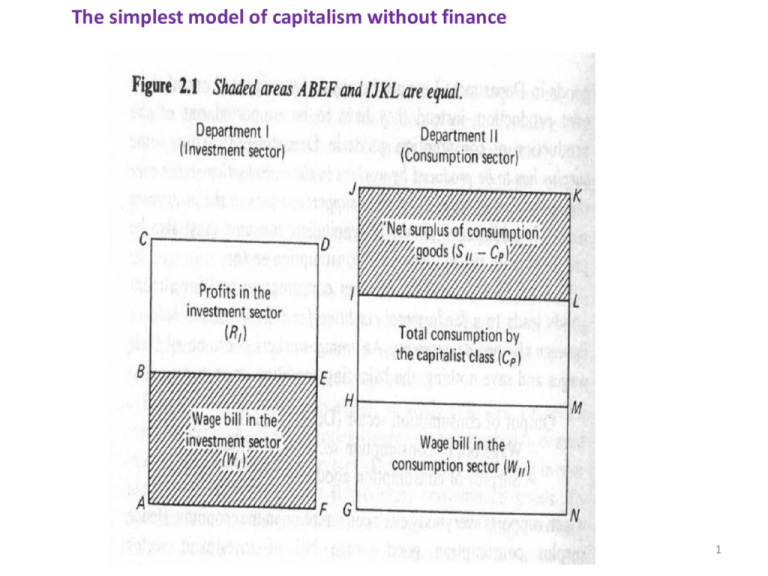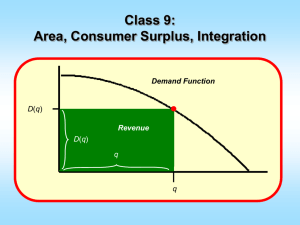The simplest model of capitalism without finance B
advertisement

The simplest model of capitalism without finance
1
Physical
Surplus of
consumption
goods valued
at existing
price
Physical
Surplus of
investment
goods valued
at existing
price
WC
B-SECTOR
WI
Lc
Surplus (net
realizable
profit) of
valued at
existing price
WB
Li
F-SECTOR
xF
I-SECTOR
xB
C-SECTOR
xi
xc
THE SIMPLEST MODEL WITH FINANCE
Surplus (net
realizable
profit) of
valued at
existing price
WF
LB
LF
In the simplest model of capitalism with finance
(1) All wages (and salaries) are consumed i.e. spent on the consumption sector (C)
(2) All profits are saved
(3) No government but there is a banking sector (B) regulated by a central bank which is also lender of last resort.
(4) No foreign trade of capital flows in the closed economy .
(5) The finance sector (of investment banks , mutual funds ) is not regulated by the central bank and has no lender of last resort.
{In reality “ too big to fall “ argument of “moral hazard “ from that}
2
Realization of surplus of the
consumption sector into money profit
(1) How the market is provided for surplus beyond ‘self –
consumption ‘ by workers in the consumption sector.
Equation (1) WI + WB + WF= (Surplus)c = Suc = Rc
(2) Note if other sectors (I, B, F) smaller or bigger, There would be less
or more demand for surplus of C.
(3) If wage (in terms of consumption goods ) is smaller more surplus is
available in C sector , but less surplus is needed by other sectors.
Therefore , ‘other things equal ‘ , lower wage rate makes the
problem of surplus realization into profit greater, but more
generation of surplus.
‘
3
‘Value added’ by a sector is wage + profit
( after all raw materials are netted out)
Value added by sector I = I = xI LI
Value added by sector B = B = xB LB
Value added by sector F = F = xF LF
Value added by sector C = C = xC LC
Value added per worker : xj (j = I, B, F, C )
Potential profit (with or without realization into money
profits):
R*C , R*I , R*B , R*F
As above,
Equation(2): WI+WB+WF = R*C = RC
Unrealized potential profit is addition to inventories
notionally valued at existing price.
4
*
So, (Su)C ≡ Rc
(identity)
But (Su)C= RC*
(equation)
The equation is satisfied only when
RC*- RC = 0
i.e. no unplanned accumulation of inventories or no unplanned unsold goods.
*
(B-WB) =RB
(I-WI)*= RI
(F-WF) *= RF
Total value added by non-consumption good sectors:
Equation(3): B+I+F = (R*B+R*I+R*F) + (WB+WI+WF)
Endogenous Money : Modern Credit System.
There is cash (and demand deposit) created as liability of the Central
Bank.
5
Banks have access to central bank cash/ liability as their
lender of last resort. But they can credit vis-à-vis the
public for all profitable lending outlets which makes bank
credit –(money) demand determined i.e. endogenous
money supply (Deposits follow rather than precede, and
also gap can be filled by inter-bank money market
borrowing and by the lender of last resort in extreme
cases).
This means there is no excess money supply or
inventories unlike consumption and investment sector.
Demand determined potential=actual profit of banks i.e.
Equation(4) , * RB = RB
By similar argument where financial sector borrowing
and derivative/ swap agreements for the financial sector.
6
Equation(5) , 𝑅𝐹 ∗ = 𝑅
The only difference (and a root cause of crisis) is
there is no lender of last resort and no supervision,
but money guaranteed by central bank as its own
liability (cash) or of the supervised banks (demand
deposits) are needed for final settlement in case of
default/margin contraction.
7
From equation (and identities),
(2), (3), (4) and (5)
Equation (6) B+I+F = (RB + RI* + RF + RC ) = R
[only unsold investment goods remain as inventories in
(6). Also consumption goods, if not all is sold]
B = N, can be interpreted as the net interest income of
banks on the credit advanced (assuming that is the
only operation deposit banks perform)
F = IF = demand-determined
size of the financial market=financial investment
i.e. investment in financial markets on
securities/derivates etc. by other sectors.
8
Equation (7): IR + IF = (R –B) = Profit net of interest
payments = 𝜋.
(IR = I for notational symmetry)
(7) is the fundamental equation we would explain its
implications.
9
Equation (7) is of fundamental importance for three main
reasons.
(1) It is a special case of expenditure (demand) and
income (output) equality also known as investment
saving equality. It can be generalized to more
complicated cases where only part of profit or wage
is saved, mixed income households earning both
profit and wage and borrowing from banks. In this
special case, IR represents demand for real goods and
services, IF represents demand for investment in
paper assets (claim on income from profit). Saving
equals profit because all profit and no wage is saved.
10
(ii) It shows that investment is a mixture of partly real
expansion of productive capacity and partly portfolio
investment as claims of existing (secondary market) or
newly created (primary market) (It is both making and
buying, and not a micro-economic ‘make‘ versus ‘buy’
choice).
(iii) The sector producing real investment goods may over(or under)-produce with unplanned inventory
accumulation to make the equation an identity with
insufficient profit realization. The finance sector in
contrast holds no unplanned inventories but has
perfectly elastic supply potential adjusting
instantaneously to demand.
11
Adjustments
If IR increases, there may be quantity adjustment or pricewage adjustment to change distribution to result in more
profit (= saving).
If IF changes there will be similar adjustment , more supply
of financial securities at fixed price or a rise in security
prices and potential capital gains resulting in more profit
(= saving)
In case of capital gains the system has a tendency to
destabilize as high expected capital gains can shift
investment expenditure in favour of capital gains.
12
If total investment increases (because capital gains make
banks healthier and households more credit worthy)
both real sector and financial sector expand. If the
composition change sufficiently in favour of financial
investment, real economy may stagnate while the
financial economy expands (elasticity condition real and
financial investment)
example IR+ IF
10
15
IR
7
6
IF
3
9
13
To interpret the relevance of the model recall its basic assumption that each sector is
vertically integrated through physical inputs and self-sufficient, except for financial
linkages, in so far as it can grow on its own without being dependent to other sectors
in terms of physical input supply. The interlinkages are essentially due to demand for
physical goods and credit requirements.
Real sector
That is, consumption sector (C ) produces a homogeneous consumption good for
all classes, but only workers consume for simplification of exposition. Similarly
the investment sector (I) produces capacity creating or enhancing good for all
sectors.
Financial sector
Banks (B ) deal in lending credit money as ultimate means of settlements
guaranteed by the central bank. They lend against future income streams of the
other sectors. Workers do not borrow for simplified exposition.
Financial sector(F) buys debts of other sectors and securitizes them and
guarantees them internally through credit rating without central bank
supervision or guarantee, and sell them to the other sectors which now becomes
the assets held by other sectors.
14







